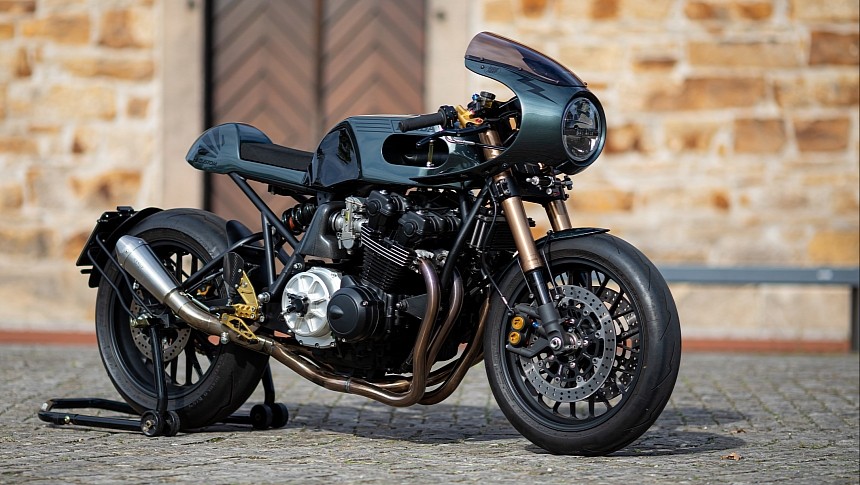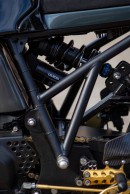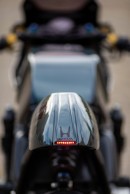Holger Breuer’s breathtaking customs have graced the autoevolution pages on countless occasions, and it’s always a delight to see what he can pull off. Each and every bike he puts together is special in some way, but the striking cafe racer we’re about to look at really dials the cool factor to eleven. The project was commissioned by one of Holger’s close friends, who sought a custom Honda CB900F like no other.
To be more exact, the only Honda part you’ll find here is the inline-four engine, because the guys had big plans for the framework. HB-Customs' mastermind was able to find an ultra-rare, race-prepped skeleton built by Manfred Rau back in 1977, which is one hell of a find, indeed! If you think the Rau frame must’ve cost a small fortune, then you are absolutely correct.
However, the client’s wishes weren’t dictated by a fixed budget, but rather by the desire to own and ride something truly exquisite. He was thus more than happy to splash out on this project, and the aforementioned frame is just one of many tantalizing features you’ll find here. Before placing the CB900F’s motor inside the new tubing, Holger wanted to extract some additional power.
He achieved this with a comprehensive rebuild, which inflated the engine’s displacement to a beefier 1,062cc. The cylinders were bored out to accommodate forged Mahle pistons, while the stock carbs have been deleted to make room for Mikuni RS36 substitutes. These bad boys inhale via a tailor-made carbon fiber airbox, and they’re joined by a four-into-one Schule exhaust at the other end of the combustion cycle.
HB-Custom added a hydraulic clutch and a modern electronic ignition module, as well, with all these upgrades resulting in just under 100 hp at the rear wheel. As far as the motorcycle’s suspension is concerned, you will now find the inverted forks and triple clamps of a Suzuki GSX-R1000 K7 at the front. Out back, Holger installed a top-grade shock absorber developed by Wilbers.
The same brand also supplied a steering damper to keep this machine nice and stable at high speeds. In the unsprung sector, you’ll encounter a premium pair of 17-inch wheels from PVM, wearing sticky Pirelli Diablo Supercorsa rubber fore and aft. Stopping power comes from a mixture of modern braking components from two different Yamahas – a mid-range R6 and its larger sibling, the mighty R1.
With all the mechanical upgrades taken care of, the project’s author turned his attention to the bodywork. He used aluminum sheets to fabricate a complete outfit from scratch, and its centerpiece is a handsome gas tank with knee indentations, a flush-mounted filler cap, and a tubular fuel gauge on the right. Behind this new tank is slender cafe-style tail section topped with a plain saddle.
There are two separate fenders surrounding the rear wheel – one attached right in front and the other sitting on a swingarm-mounted license plate bracket at the back. We see a bespoke fender at twelve o’clock, too, but the most enticing item in that area is the front fairing. It sits on tailor-made mounting hardware, encircles a sizeable LED headlight supplied by Koso, and is topped with a tinted MRA windshield.
On the other hand, the taillight placed at the back is a small, yet sufficiently bright Highsider part, complemented by Kellermann LED turn signals all-round. Gilles Tooling supplied the CNC-machined rearsets and clip-on handlebars, with the latter featuring Magura control levers, plain rubber grips, and Highsider switchgear. There is also an aftermarket speedometer and a keyless RFID ignition setup, both hailing from Motogadget.
For the finishing touch, the bodywork was wrapped in layer of dark teal paint and black accents. Most of the bike’s other components were either powder-coated or painted matte-black, with slight pinches of gold appearing on parts like the master cylinders, foot controls, and rear sprocket. All things considered, it’s safe to say that Holger Breuer aced this transformation from start to finish.
However, the client’s wishes weren’t dictated by a fixed budget, but rather by the desire to own and ride something truly exquisite. He was thus more than happy to splash out on this project, and the aforementioned frame is just one of many tantalizing features you’ll find here. Before placing the CB900F’s motor inside the new tubing, Holger wanted to extract some additional power.
He achieved this with a comprehensive rebuild, which inflated the engine’s displacement to a beefier 1,062cc. The cylinders were bored out to accommodate forged Mahle pistons, while the stock carbs have been deleted to make room for Mikuni RS36 substitutes. These bad boys inhale via a tailor-made carbon fiber airbox, and they’re joined by a four-into-one Schule exhaust at the other end of the combustion cycle.
HB-Custom added a hydraulic clutch and a modern electronic ignition module, as well, with all these upgrades resulting in just under 100 hp at the rear wheel. As far as the motorcycle’s suspension is concerned, you will now find the inverted forks and triple clamps of a Suzuki GSX-R1000 K7 at the front. Out back, Holger installed a top-grade shock absorber developed by Wilbers.
The same brand also supplied a steering damper to keep this machine nice and stable at high speeds. In the unsprung sector, you’ll encounter a premium pair of 17-inch wheels from PVM, wearing sticky Pirelli Diablo Supercorsa rubber fore and aft. Stopping power comes from a mixture of modern braking components from two different Yamahas – a mid-range R6 and its larger sibling, the mighty R1.
With all the mechanical upgrades taken care of, the project’s author turned his attention to the bodywork. He used aluminum sheets to fabricate a complete outfit from scratch, and its centerpiece is a handsome gas tank with knee indentations, a flush-mounted filler cap, and a tubular fuel gauge on the right. Behind this new tank is slender cafe-style tail section topped with a plain saddle.
There are two separate fenders surrounding the rear wheel – one attached right in front and the other sitting on a swingarm-mounted license plate bracket at the back. We see a bespoke fender at twelve o’clock, too, but the most enticing item in that area is the front fairing. It sits on tailor-made mounting hardware, encircles a sizeable LED headlight supplied by Koso, and is topped with a tinted MRA windshield.
On the other hand, the taillight placed at the back is a small, yet sufficiently bright Highsider part, complemented by Kellermann LED turn signals all-round. Gilles Tooling supplied the CNC-machined rearsets and clip-on handlebars, with the latter featuring Magura control levers, plain rubber grips, and Highsider switchgear. There is also an aftermarket speedometer and a keyless RFID ignition setup, both hailing from Motogadget.
For the finishing touch, the bodywork was wrapped in layer of dark teal paint and black accents. Most of the bike’s other components were either powder-coated or painted matte-black, with slight pinches of gold appearing on parts like the master cylinders, foot controls, and rear sprocket. All things considered, it’s safe to say that Holger Breuer aced this transformation from start to finish.










